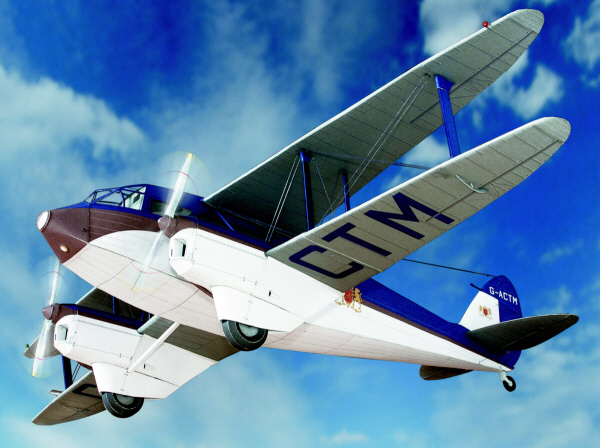

Perhaps no other aircraft captures the spirit of commercial flying
in the 1930s than the Dragon Rapide. While the biplane design
still hearkens back to the early days of flying, the small enclosed
passenger cabin presages the comparative comfort of post-war air
travel with the proliferation of executive jet transport. Designed
as a direct development of the DH 84 Dragon but with tapered wings,
the Dragon Rapide was powered by two 200hp Gipsy Six engines.
Making its maiden flight on 17th. April 1934, the aircraft was
to remain in production for about ten years, with over 700 being
built. Bought by both civil and military customers, the type played
an important role on air routes in the UK and in many parts of
the British Commonwealth. Having exceptional airfield performance,
the Dragon Rapide was designed to carry up to 8 passengers and
crew at a cruising speed of 132 mph and a range of 580 miles.
The aircraft was very popular, especially with the rich and famous
and counted Edward VIII among its owners. The RAF was the largest
customer for the aircraft and during the war, the Dragon Rapide
saw service as the DH Dominie radio and navigation trainer. While
production ceased at the end of the war, the RAF continued to
use the machine, mainly for civil flights up to the 1990s. It
is a tribute to the design and durability of the Dragon Rapide
that some are still in service today.
Designed by Pawel Mistewicz, the Schreiber kit is depicted in
the blue and white livery of the cigarette manufacturer, Rothmans.
Printed on seven sheets of A3 card, in accordance with Schreiber's
practice, the kit also contains several sheets of heavy card for
backing up some of the internal parts. As well as a series of
20 excellent diagrams, construction is also explained in text
provided in both German and English. As the instructions are printed
on the reverse of some parts, it is necessary to copy these before
starting construction. The following is a review of the kit straight
from the box without building.
The model is provided with an optional full cabin interior and
so the first decision to make is whether to build this with glazed
windows. Construction then begins with the cabin interior. The
seven passenger seats are installed, each with a seat belt placed
across the seat. The cabin floor and sides are assembled. The
cockpit is added with a control console including joystick and
pedals. Formers are added on top of and below the capsule to support
the fuselage shape. The after structure of the fuselage is then
attached, after which the outer sides of the cabin and fuselage
are put into position. Just prior to this, glazing can be applied
between the inner and outer fuselage sides. The fixed tail-wheel
assembly is constructed and placed in position, followed by the
spars for the inboard sections of the lower wing, which are situated
on the underside of the fuselage. With the addition of aerofoil
sections to the spars, it is possible to wrap the coverings for
the wing sections around the spars. The rear segments of the engine
nacelles are assembled and fitted to the underside of the wings.
The spinner assembly is then inserted into the main part of the
nacelle, which, with the rear upper fairing, is then attached
to the wing. The two main wheels are constructed as shallow cylinders,
with outer ridged elements to give the right tyre profile. It
would appear from the diagram that careful fixing of the axle
will leave the wheel free to rotate.
Work then turns to the upper wings. Again, these are built in
two halves, each of which is attached to a side of the fuselage.
The wing spar and aerofoil sections are glued together and assembled
on a base plate. The wing covering is then wrapped around the
base plate, making sure that the wing surface conforms to the
skeleton structure beneath. In a similar fashion, the outboard
sections of the lower wings are constructed. Before the upper
wing can be attached to the fuselage, wing struts are constructed
and attached to the lower wing sections. After the upper wing
ahs been fixed to the fuselage and supported by the wing struts,
the outer sections of the lower wing, again with struts added,
can be positioned.
The remaining pieces covering are then applied to top and bottom
of the fuselage. The tail plane and fin are then added and the
model is rounded off with the attachment of the cockpit canopy.
With a wingspan of just over 2 feet, this is a substantial model.
The quality of printing is excellent with the wings being printed
in an attractive silver-grey, with rib-outlines showing through.
If there is one criticism, it is that the English instructions
are not a complete translation of the German; parts are omitted
and some of the terms used are a trifle obscure. Nevertheless,
the diagrams are clear and understandable and should suffice for
the experienced modeller at whom this kit is aimed.
In summary, with this fine kit, Schreiber have done ample justice
to an attractive and popular subject.
Christopher Cooke